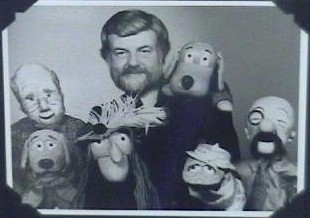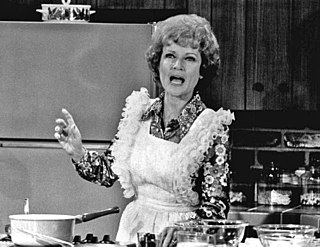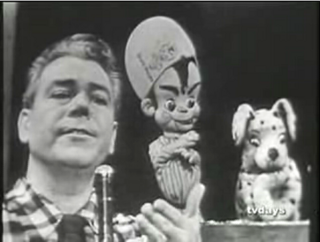
Captain Kangaroo is an American children's television series that aired weekday mornings on the American television network CBS for 29 years, from 1955 to 1984, making it the longest-running nationally broadcast children's television program of its day. In 1986, the American Program Service integrated some newly produced segments into reruns of past episodes, distributing the newer version of the series to PBS and independent public stations until 1993.

Mister Rogers' Neighborhood is an American half-hour educational children's television series that ran from 1968 to 2001, and was created and hosted by Fred Rogers. The series Misterogers debuted in Canada on October 15, 1962, on CBC Television. In 1966, Rogers moved back to the United States creating Misterogers' Neighborhood, later called Mister Rogers' Neighborhood, on the regional Eastern Educational Television Network. The US national debut of the show occurred on February 19, 1968. It aired on NET and its successor, PBS, until August 31, 2001.
Hot Fudge is an American children's television series that was produced in Detroit by WXYZ-TV and distributed by the Lexington Broadcast Services Company. Originally airing only in Detroit beginning in 1974, the show grew in popularity and was syndicated nationally from 1976 to 1980; a few of WXYZ's sister ABC-owned stations carried the program.

Howdy Doody is an American children's television program that was created and produced by Victor F Campbell and E. Roger Muir. It was broadcast on the NBC television network in the United States from December 27, 1947, until September 24, 1960. It was a pioneer of children's programming and set the pattern for many similar shows. One of the first television series produced at NBC in Rockefeller Center, in Studio 3A, it pioneered color production in 1956 and NBC used the show to promote color television sets in the late 1950s.

Pincus Leff, better known as Pinky Lee, was an American burlesque comic and host of the children's television program The Pinky Lee Show in the early 1950s.
Pinwheel is an American children's television show and the first to air on Nickelodeon, as well as the first to appear on Nickelodeon's Nick Jr. block. The show was aimed at preschoolers aged 3–5. It was created by Vivian Horner, an educator who spent her earlier career at the Children's Television Workshop, the company behind Sesame Street. The show was geared to the "short attention span of preschoolers," with each episode divided into short, self-contained segments including songs, skits, and animations.

Beakman's World is an American educational children's television program. The program is based on the Universal Press Syndicate syndicated comic strip You Can with Beakman and Jax created by Jok Church. The series premiered on Wednesday, September 16, 1992, on TLC, and on various other channels a few days later through syndication on 220 other channels.

Nick News is an American educational television news magazine aimed at children and teenagers. It originally aired on Nickelodeon from 1992 to 2015. It also aired on Nickelodeon's sister network Noggin from 1999 to 2002. Nick News took the form of a highly rated and recognized news program for children and teenagers alike, discussing important social, political and economic issues in a format intended for both children and adults. In June 2020, the show was revived.

Oobi is an American children's television series produced by Little Airplane Productions for the Noggin channel. The show's concept is based on a training method used by puppeteers, in which they use their hands and a pair of glass eyes instead of a full puppet. The main character is a bare hand puppet named Oobi. The first season was a series of two-minute shorts. For its second and third seasons, it became a long-form series, with episodes lasting 13 minutes each. The show originally aired from 2000 to February 11, 2005, with reruns continuing until March 18, 2013.
WOI – branded Iowa Public Radio – is a non-commercial educational radio station licensed to serve Ames, Iowa. Owned by Iowa State University, the station covers the Des Moines metropolitan area. Broadcasting a mix of public radio and talk radio, WOI is the flagship station for Iowa Public Radio's News Network and the market member station for NPR, Public Radio International, and the BBC World Service. The WOI studios are located at Iowa State University's Communications Building, while the station transmitter resides southwest of Ames. Besides a standard analog AM transmission, WOI is relayed over low-power Ames FM translator K234CN and is available online.

WOI-DT is a television station licensed to Ames, Iowa, United States, serving the Des Moines area as an affiliate of ABC. It is owned by Tegna Inc. alongside CW affiliate KCWI-TV, also licensed to Ames. Both stations share studios on Westown Parkway in West Des Moines, while WOI-DT's transmitter is located in Alleman, Iowa.

KCWI-TV is a television station licensed to Ames, Iowa, United States, serving as the CW affiliate for the Des Moines area. It is owned by Tegna Inc. alongside ABC affiliate WOI-DT, also licensed to Ames. Both stations share studios on Westown Parkway in West Des Moines, while KCWI-TV's transmitter is located in Alleman, Iowa.

Razzle Dazzle is a Canadian children's television program produced by the Canadian Broadcasting Corporation between October 2, 1961, and July 1, 1966.

The Floppy Show is an American children's television series starring Duane Ellett, broadcast on NBC affiliate WHO-TV in Des Moines, Iowa from 1957 to 1987. Ellett created Floppy in early 1957 to help teach people how to take care of their pets on the TV show Pet Corner, before moving on to their own show.

Sue Ann Nivens is a fictional character portrayed by Betty White on situation comedy The Mary Tyler Moore Show.

Charles John Thomas McCann was an American actor, comedian, puppeteer, commercial presenter and television host. He was best known for his work in presenting children's television programming and animation, as well as his own program The Chuck McCann Show and he also recorded comedy parody style albums.
The Uncle Al Show was a children's television program originating in Cincinnati. The show was hosted by Cleveland native Al Lewis (1924–2009), and later was co-hosted by his wife, Wanda.
Betty Lou Varnum was an American television personality, best known as host of the long-running children's show, The Magic Window.

Rootie Kazootie was the principal character on the 1950-1954 children's television show The Rootie Kazootie Club. The show was the creation of Steve Carlin and featured human actors along with hand puppets.
The 1952 Sylvania Television Awards were presented on December 11, 1952, at Hotel Pierre in New York City. The Sylvania Awards were established in 1951 by Sylvania Electric Products. Deems Taylor was the chairman of the judges committee.














